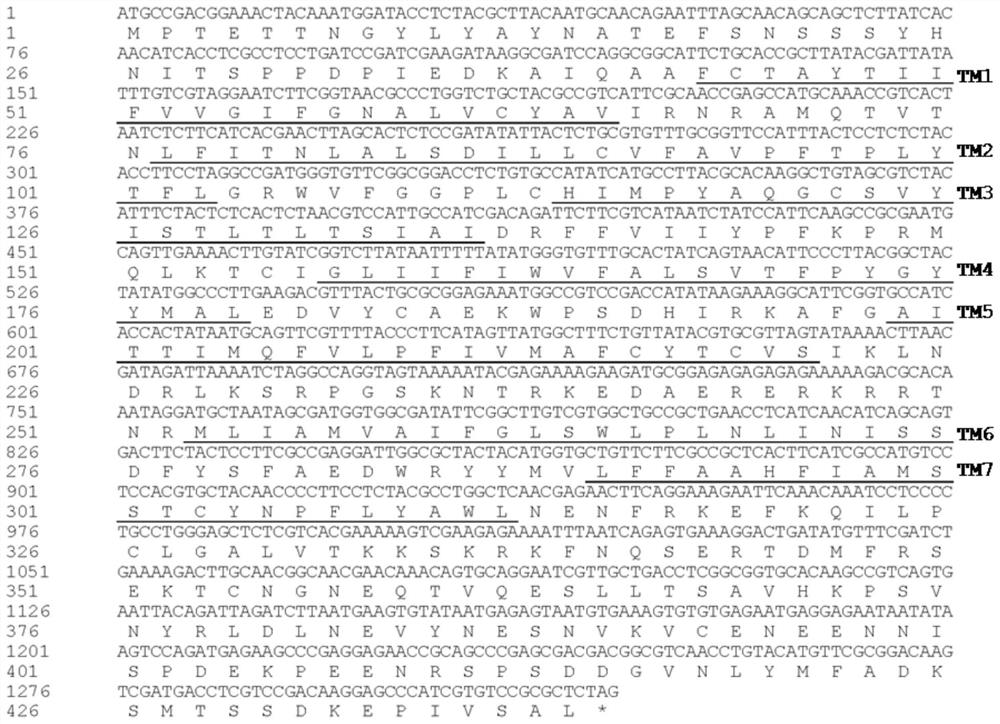Neuropeptide cv-snpf and its receptor in Plutella xylostella xylostella and its application in increasing trehalose content in Plutella xylostella
A technology of Plutella xylostella and neuropeptide, which is applied in the fields of molecular biology and genetic engineering, can solve problems that do not involve regulation mechanisms and the like, and achieve the effect of increasing the content of trehalose
- Summary
- Abstract
- Description
- Claims
- Application Information
AI Technical Summary
Problems solved by technology
Method used
Image
Examples
Embodiment 1
[0033] 1. Acquisition of the ORF sequences of the Cv-sNPF gene of Plutella xylostella xylostella and the Px-sNPFR gene of Plutella xylostella
[0034] (1) Collect Plutella xylostella larvae and Plutella xylostella larvae: take the Plutella xylostella about 5-6 days after parasitization, and dissect it in insect culture medium under a microscope. Tear a hole first to facilitate the larvae to slide out, add new medium, wash several times, discard the washing liquid, add pre-cooled 1ml TRIzol, grind and store at -80°C for later use; take the diamondback moth that has grown to the 4th instar Three larvae were washed with alcohol and placed in 1ml TRIzol, ground and stored at -80°C for later use.
[0035] (2) Using the TRIzol method to extract the total RNA of Plutella xylostella and Plutella xylostella, and then use the kit SuperScript TM II Reverse Transcritase (Invitrogen) was used to synthesize cDNA first strand.
[0036] (3) Based on the transcriptome data of Plutella xylos...
Embodiment 2
[0055] 1. Synthesis of Cv-sNPF mature peptide and preparation of specific antibody
[0056] Protean software was used to analyze the hydrophilicity and secondary structure of the peptide precursor protein sequence, and a specific 10-20aa fragment was selected for synthesis (as shown in SEQ ID NO.5). The synthetic sequence is shown in Table 2. The synthesized short peptide was sent to Shanghai Sangon Biological Co., Ltd. for synthesis, and a total of 5 mg was synthesized with a purity of >90%. Antibodies are prepared using a synthetic polypeptide (such as SEQ ID NO.5) as an antigen.
[0057] Table 2 Design and synthesis of short peptide sequences
[0058]
[0059] 2. The localization of Cv-sNPF in the nervous system of the larvae of Plutella xylostella
[0060] 2.1 Dissection of different tissues
[0061] Take 10-20 larvae of the same age and the same growth and development of Plutella xylostella, dissect the brain tissue under a stereo microscope, and put it in cold PBS ...
Embodiment 3
[0080] 1. Screening of stably transfected cell lines
[0081] 1.1 Construction of eukaryotic expression vector
[0082] Using the primers designed as follows (Table 3), PCR amplifies the Px-sNPFR gene fragment with restriction sites, and through conventional methods of constructing vectors such as double digestion, ligation, and transformation, the Px-sNPFR is connected to the eukaryotic expression Vector pcDNA3.1.
[0083] Table 3 Construction of primers for eukaryotic expression vectors with restriction sites
[0084]
[0085] 1.2 Cell culture, transfection and screening
[0086] HEK293 cells were cultured using DMEM high-glucose medium produced by Invitrogen, supplemented with inactivated 10% fetal bovine serum (Fetal Bovine Serum, FBS) medium. Cells were cultured at 37°C, 5% CO2 incubator (ThermoScientific). The cell subculture was carried out in a sterilized bench, and it was sterilized by ultraviolet light for more than 20 minutes before starting. During operatio...
PUM
| Property | Measurement | Unit |
|---|---|---|
| molecular weight | aaaaa | aaaaa |
| molecular weight | aaaaa | aaaaa |
Abstract
Description
Claims
Application Information
 Login to View More
Login to View More - R&D
- Intellectual Property
- Life Sciences
- Materials
- Tech Scout
- Unparalleled Data Quality
- Higher Quality Content
- 60% Fewer Hallucinations
Browse by: Latest US Patents, China's latest patents, Technical Efficacy Thesaurus, Application Domain, Technology Topic, Popular Technical Reports.
© 2025 PatSnap. All rights reserved.Legal|Privacy policy|Modern Slavery Act Transparency Statement|Sitemap|About US| Contact US: help@patsnap.com



